
Acupuncture is a form of medical treatment in which an acupuncturist inserts very fine needles into particular points on the body to treat diseases. There are more than 360 acupuncture treatment points. Acupuncture needles used are very thin, sharp, and flexible and are almost painless. Acupuncture does not hurt. Patients may feel just a small sensation at the time of insertion or not feel anything at all. No medicine is injected at the point of insertion of an acupuncture needle. There are almost no side effects of acupuncture treatment.
Modern acupuncture takes this traditional practice one step further, incorporating scientific principles and cutting-edge technology to enhance the effectiveness of treatment. This therapy is often used as an alternative therapy by an alternative medicine practitioner to treat a wide range of conditions, including chronic pain, stress, anxiety, and digestive disorders.
Acupuncture has been a part of traditional Chinese medicine for centuries. In recent years, modern acupuncture has emerged as a popular form of alternative therapy, combining traditional techniques with modern science to achieve optimal results. While it is most commonly associated with pain relief, it has also been used to address a variety of other health concerns, including weight loss. Acupuncture for hair loss has been quite effective. Acupuncture for hair growth is a popular treatment option for those struggling with thinning or balding hair. Similarly, acupuncture for weight loss is effective in promoting weight management by reducing cravings and boosting metabolism. Acupuncture for belly fat and acupuncture for gallstone pain are other potential applications of this technique, while acupuncture for heel pain can be a useful treatment option for those dealing with foot pain or plantar fasciitis.
One of the main differences between traditional acupuncture and modern acupuncture is the integration of Western medical concepts and terminology. For example, modern acupuncture may use acupuncture points that correspond to specific nerves, muscles, or trigger points in the body, based on Western anatomical and physiological knowledge.
Additionally, modern acupuncture practitioners may use advanced technology to enhance the effectiveness of treatment. For example, some practitioners may use electrical stimulation to enhance the effect of the needles or use laser acupuncture, which uses low-level laser light to stimulate the acupuncture points.
Many scientists have spent their lifetime deciphering the rationale behind the mode of action of acupuncture. Modern science has now come to the stage of understanding the possible mode of action of acupuncture. We are very near to deciphering the exact secret. Acupuncture stimulates connective tissue, nerve ending, periosteum, and other tissues, resulting in a variety of reactions. The stimulation causes the body to release several neuro-hormones like enkephalins, bet-endorphin, and dynorphin which help the body to relieve pain and heal itself. Stimulation of certain nerve fibers causes the spinal cord to act as a gate, to block pain stimuli, which would have forwarded to the brain.
The fact remains that acupuncture works and works very well. As per the figure, acupuncture acts on descending pathway of the hypothalamus blocking perception of pain passing through the spinal cord.
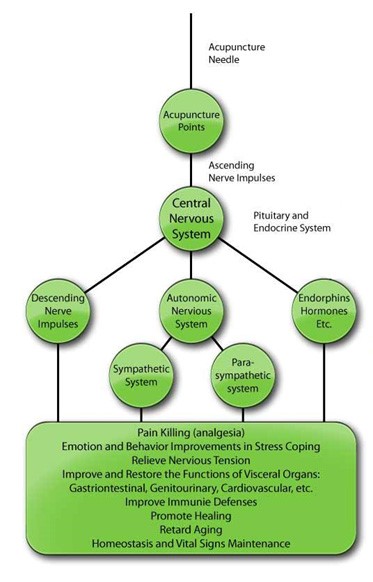
Acupuncture needles are inserted at a particular point or area expecting the desired effect. Modern research has shown that the very act of insertion of a needle in the body stimulates connective tissue, nerve ending, periosteum, and other tissues resulting in a variety of reactions. The stimulation causes the body to release several neuro-hormones which helps the body to heal itself and relieve pain. Stimulation of certain nerve fibers causes the spinal cord to act as a gate, which blocks pain stimuli that would have forwarded to the brain.
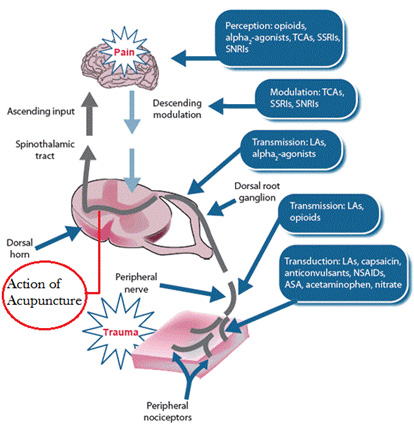 Three types of nerves namely are involved in the perception of pain due to tissue damage. A-Beta fibers are large-diameter myelinated fibers, A-Delta fibers are small-diameter myelinated fibers, and C fibers are small-diameter unmyelinated fibers. A-Delta fibers are responsible for the accurate localization of pain and are without emotional accompaniment. On insertion of acupuncture needle stimulation, A- Delta fibers, sends its sense of stimulating activity to the hypothalamus, which stimulates the inhibitory system of the brain stem. The brain stem system involving serotonin and noradrenalin ultimately acts on SG cells in the posterior horn of the spinal cord where the pain pathway is blocked. Thus, acupuncture acts on descending pathway of the hypothalamus blocking perception of pain passing through the spinal cord.
Three types of nerves namely are involved in the perception of pain due to tissue damage. A-Beta fibers are large-diameter myelinated fibers, A-Delta fibers are small-diameter myelinated fibers, and C fibers are small-diameter unmyelinated fibers. A-Delta fibers are responsible for the accurate localization of pain and are without emotional accompaniment. On insertion of acupuncture needle stimulation, A- Delta fibers, sends its sense of stimulating activity to the hypothalamus, which stimulates the inhibitory system of the brain stem. The brain stem system involving serotonin and noradrenalin ultimately acts on SG cells in the posterior horn of the spinal cord where the pain pathway is blocked. Thus, acupuncture acts on descending pathway of the hypothalamus blocking perception of pain passing through the spinal cord.
The Cingulate Gyrus, hippocampus, amygdala, and part of the hypothalamus and thalamus form the limbic system. It is connected with the cerebral cortex and responsible for the modulation of pain perception emotion and the formation of memory. Since patients undergoing acupuncture frequently experience relaxation, and euphoria or may laugh or cry; the effect may be due to its effect on Cingulate Gyrus which also modulates pain, thus we have a reduced perception of pain.
There are three classes of opioids in analgesia – enkephalins, bet-endorphin, and dynorphin. Low-frequency electro-acupuncture stimulates the brain and spinal cord to release enkephalins and bet-endorphin. High-frequency electro-acupuncture stimulation stimulates the release of dynorphin in the spinal cord. These opioids along with serotonin and oxytocin may be responsible for acupuncture analgesia. Thus, stimulation of distant parts of the body has an effect on the Brain as seen from the above facts.
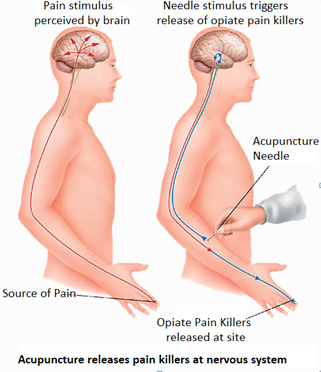 According to NHS UK, "Western medical acupuncture is the use of acupuncture following a medical diagnosis. It involves stimulating sensory nerves under the skin and in the muscles of the body. This results in the body producing natural substances, such as pain-relieving endorphins. These naturally released substances are likely responsible for the beneficial effects experienced with acupuncture.
According to NHS UK, "Western medical acupuncture is the use of acupuncture following a medical diagnosis. It involves stimulating sensory nerves under the skin and in the muscles of the body. This results in the body producing natural substances, such as pain-relieving endorphins. These naturally released substances are likely responsible for the beneficial effects experienced with acupuncture.
A course of acupuncture usually creates longer-lasting pain relief than when a single treatment is used. Traditional acupuncture is based on the belief that an energy, or "life force", flows through the body in channels called meridians. This life force is known as Qi (pronounced "chee"). Practitioners who adhere to traditional beliefs about acupuncture believe that when Qi does not flow freely through the body, this can cause illness. They also believe acupuncture can restore the flow of Qi, and so restore health."
According to Chinese belief, health is maintained by two opposing and co-ordinating forces called Yin and Yang. Energy called Qi flows in more than 12 different channels in the body. These channels have more than 360 different points called acupuncture points. Disease conditions occur in the body due to the blockage of these points. Blockage may occur due to external or internal factors. Needling these blocked points may release the obstruction of energy and cure disease.
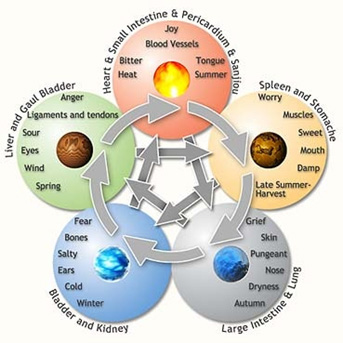 This belief was based 3000 years before when there was no knowledge of anatomy, physiology, or pathology of the human body. It is based on observation of nature and imagination of human sufferings. Said channels or energy are not perceivable in any modern technology. Moreover, we have now some ideas from modern investigations as to how acupuncture acts.
This belief was based 3000 years before when there was no knowledge of anatomy, physiology, or pathology of the human body. It is based on observation of nature and imagination of human sufferings. Said channels or energy are not perceivable in any modern technology. Moreover, we have now some ideas from modern investigations as to how acupuncture acts.
The reason is acupuncture helps the body to heal itself before it goes into full morbid disease. Diseases like viral respiratory infection respond wonderfully well to acupuncture in the initial stage than to secondary lung infection. We see patients with severe viral infection get well within 24 hours when our allopathic medicine has almost no effect on the course of viral disease. Similarly, we have been treating atonic bladder with retained urine effectively and instantly if in the initial stage.
Acupuncture needles are inserted at given points situated in a specific channel or meridian to let the patient feel a sense of minute dull ache called Qi at the point of needle insertion. Needles are inserted at varying depths depending on the point and indication. It may range from ½ cm to 8 cm. Needles are kept for varying times from 3 minutes to 45 minutes. One does not have to believe in acupuncture to get results. Many of our patients get instant results with just the insertion of acupuncture needles and feel relief as magic. Needles are later slightly moved side words or vertically to stimulate the particular point. Patients may go to sleep after the insertion of needles because of the relaxing effect of acupuncture.
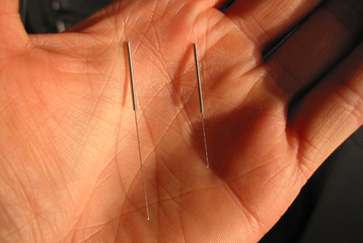 After treatment patients are asked about the status of pain or relief as in many cases relief is instant. The effect of acupuncture however increases over days or weeks. He or she is then asked to relax for 10-15 minutes before going home. Further treatments depend upon disease and response. It can be the next day, 4th day, or after the week. The correct evaluation result is evident in the next visit when the patient goes through a full cycle of daily activities for a few days. Acupuncture cost is generally far less than conventional treatments. Surprisingly pain relief by acupuncture is instant in many cases.
After treatment patients are asked about the status of pain or relief as in many cases relief is instant. The effect of acupuncture however increases over days or weeks. He or she is then asked to relax for 10-15 minutes before going home. Further treatments depend upon disease and response. It can be the next day, 4th day, or after the week. The correct evaluation result is evident in the next visit when the patient goes through a full cycle of daily activities for a few days. Acupuncture cost is generally far less than conventional treatments. Surprisingly pain relief by acupuncture is instant in many cases.
Wikipedia describes acupuncture in great detail. I am myself post-graduate allopathic consultant in obstetrics and gynecology. I have been treating lacs of patients for the last forty years. I have conducted thousands of deliveries and hundreds of major surgeries. I feel acupuncture deserves due respect and position in treating human suffering. From my critical experience and view remains a fact and conviction that acupuncture is very safe, and it works very well in the relief of human suffering due to many diseases. Insertion of the needle in the body releases certain neuro-hormones which act on the brain, spinal cord blood vessels, and other organs and let the body heal itself. How acupuncture acts is quite evident now, though not fully understood. Many other diseases are treatable by acupuncture.
There are many methods of acupuncture treatments, each suitable for different conditions and individual patients. For example, knee pain can be treated by application of needles as per the traditional method; at the knee (local); shoulder (balance); hand (Su Jok); fingers (Tung); ears (auricular), or abdomen (Turtle) as per the system of acupuncture used. This is a great advantage especially for the patient as per his preference. Another advantage of using different systems is that if one system does not give desired results another acupuncture system can be utilized.
Mental stress, anxiety, excitability, worry, early stages of depression, fearful states, and related medical conditions like hypertension hyperacidity can be very effectively helped by acupuncture in the initial stage. Many diseases where allopathic medicine does not help patients cases like the pain of hemorrhoids, dysmenorrhea, migraine, and sinusitis; are treated better by acupuncture. An important benefit of acupuncture is it is simple and there are no serious side effects. It is economical too.
Recovery from disease can be with or without residual effects. Acupuncture works best in disturbed body functions state. Its value in a healthy state is also unquestioned and should be sought first. We commonly see patients being treated for certain diseases telling us that they feel better, have a high sense of well-being, or had good sleep. This healthy state is essential as a preventive measure against general illness. The role of acupuncture here is remarkable. Diseases can be said to progress as follows.
